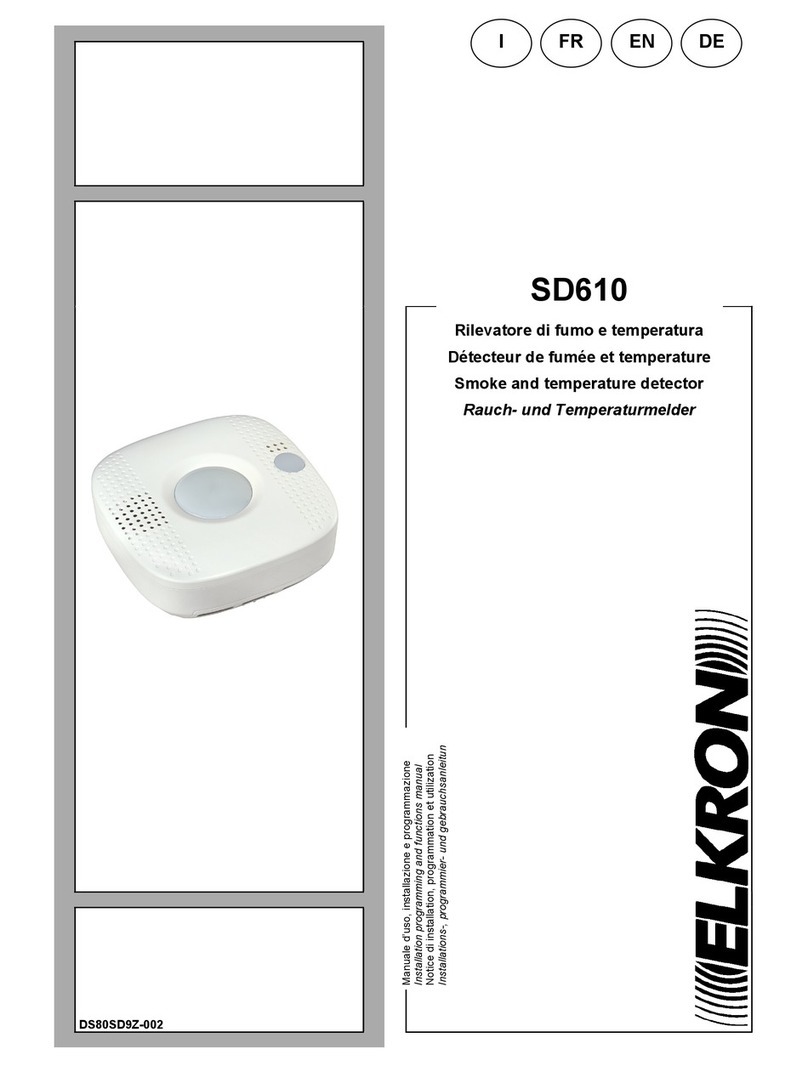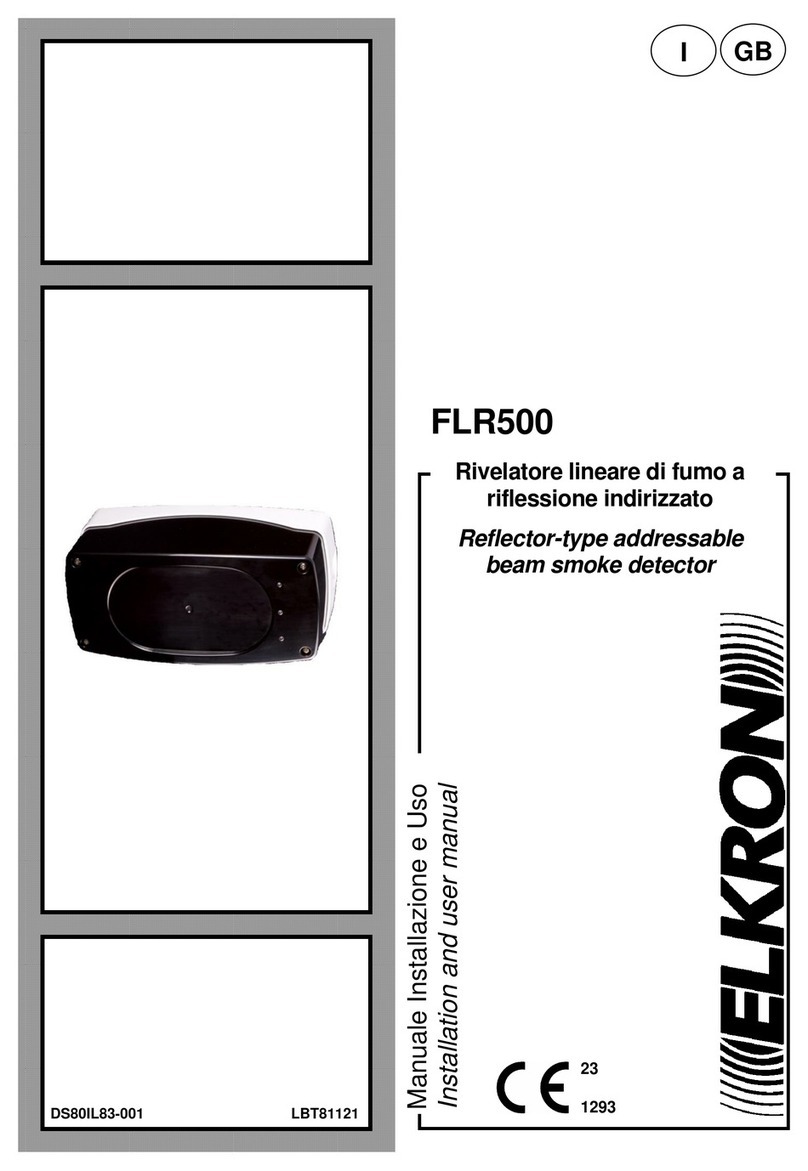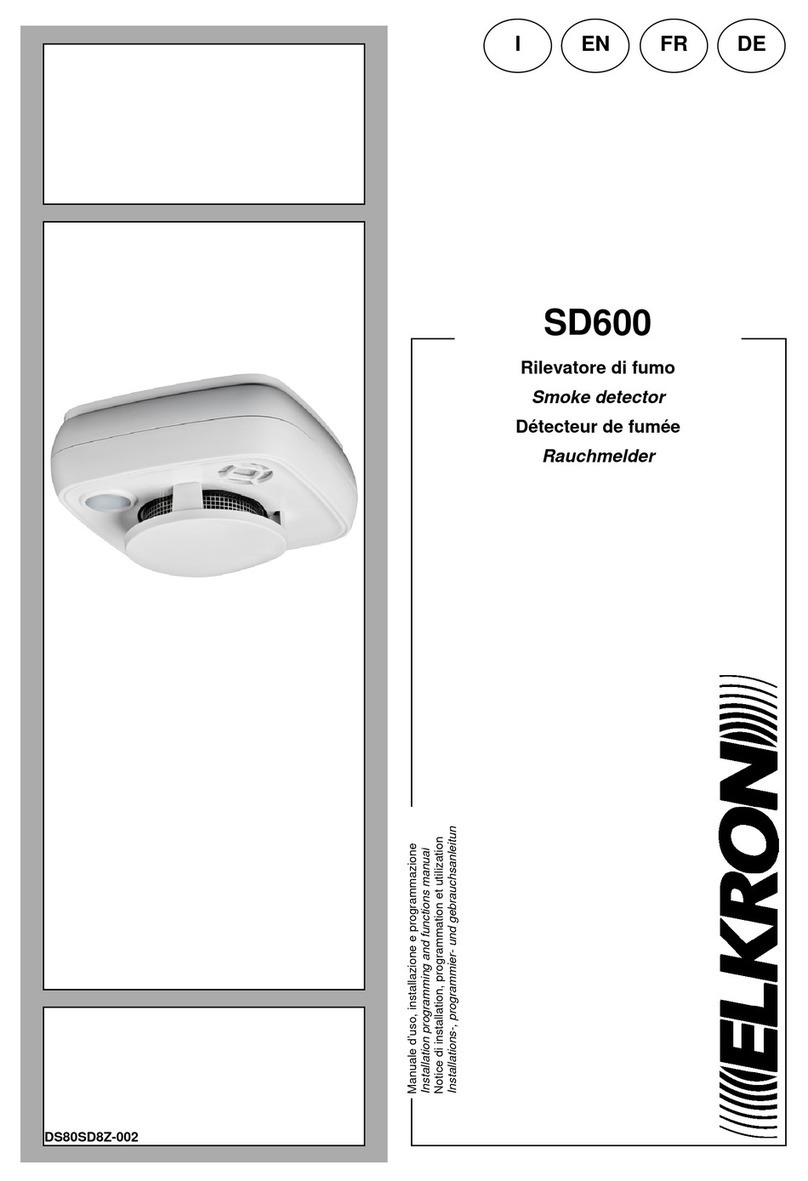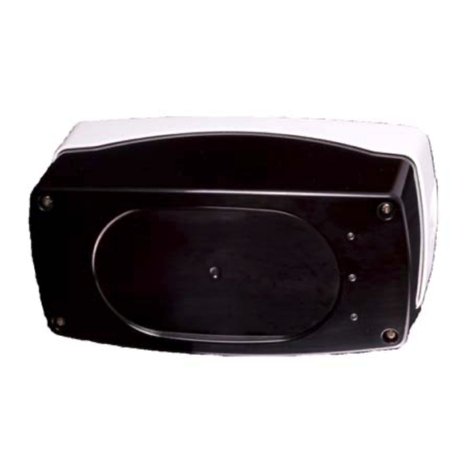
DEUTSCH
RAUCHSENSOR BIDIREKTIONALEFUNKÜBERTRAGUNG FO31WL
SENSOR DE HUMO VÍA RADIO BIDIRECCIONAL FO31WL
SENSOR DE HUMO VÍA RADIO BIDIRECIONAL FO31WL
Fig. 1
Fig. 2
TECHNISCHE EIGENSCHAFTEN
Versorgung............................... 2 Lithium/Mangandioxyd Batterien zu 3V
Typ CR123A - Format: CR17345 (IEC),
5018LC (ANSI)
Funkweite................................. bis zu 400 m im freien Raum
Abdeckung................................ 40 m2
Schalldruck Buzzer................... 85 dB (A) @ 3 m
Batteriedauer............................ 2 Jahre bei normaler Benutzung
Betriebstemperatur................... 0 °C ÷ +40 °C
Relative Luftfeuchtigkeit ........... 10 ÷ 85 %
Gehäusematerial ...................... ABS, Farbe RAL9003
Schutzgrad des Gehäuses ...... IP40 / IK02
Abmessungen (Ø x h)............... 136 x 68
INSTALLATION
1) Den Sensor durch Drehen des Deckels gegen den Uhrzeigersinn
öffnen und die Batterie unter Beachtung der Polarität einlegen (Abb. 1)
(nur bei der Erfassungsphase). Für die Erfassung und Konfiguration
des Sensors siehe das Installationshandbuch für das System WL31.
2) Das Basisteil des Sensors mit der Vorausrüstung “A” (Abb. 2) an der
Decke befestigen und so positionieren, dass der Pfeil “B” (Abb. 2) in
Richtung der Zentrale zeigt.
3) Den Sensor unter Ausrichtung des Einschnittes am Boden mit dem auf
dem Sensor schließen und den Deckel im Uhrzeigersinn drehen.
ERSATZ DER BATTERIEN
Für Ersatz der Batterien öffnen Sie den Sensor, ersetzen die Batterien
durch neue und entsorgen die verbrauchten in der vorgeschriebenen
Weise. Die ausgeführte Programmierung bleibt auch nach
Batteriewechsel bestehen.
!!! ACHTUNG !!! EXPLOSIONSGEFAHR, WENN EIN UNKORREKTER
BATTERIETYP VERWANDT WIRD. BEI BATTERIEWECHSEL
BEACHTEN SIE BITTE UNBEDINGT DIE ANWEISUNGEN. Wir weisen
darauf hin, dass Lithiumbatterien in jeder Hinsicht zum Sondermüll
mit Klassifizierungscode CER 160605 (E.W.C. 160605) gehören und
dass ihre Entsorgung nach Verbrauch genauen gesetzlichen
Vorschriften unterliegt.
ESPANOL PORTUGUES
ESPECIFICACIONES TÉCNICAS
Alimentación............................. 2 pilas de litio/dióxido de manganeso de
3 V tipo CR123A - Formatos: CR17345
(IEC), 5018LC (ANSI)
Alcance radio............................ Hasta 400 m al aire libre
Cobertura.................................. 40 m2
Presión sonora del zumbador... 85 dB (A) @ 3 m
Autonomía de la pila................. 2 años, en condiciones de empleo
normales
Temp. de funcionamiento......... 0°C ÷ +40 °C
Humedad relativa ..................... 10 ÷ 85 %
Material de la carcasa .............. ABS color RAL9003
Grado de protec. de la carcasa.IP40 / IK02
Dimensiones (Ø x h)................. 136 x 68 mm
INSTALACIÓN
1) Abrir el sensor girando la tapa en sentido antihorario e introducir la pila
(exclusivamente en el momento de la adquisición) respetando las
polaridades (fig. 1). Con respecto a la adquisición y la configuración del
sensor, remitirse al Manual de Instalación del Sistema WL31.
2) Fijar la base del sensor al techo utilizando las predisposiciones “A” (fig.
2), posicionándola de manera que la flecha “B” (fig. 2) quede en dirección
a la central.
3) Cerrar el sensor alineando la muesca que se encuentra en el fondo con
la que se encuentra sobre el sensor y girar la tapa en sentido horario.
REEMPLAZO DE LAS PILAS
Para reemplazar las pilas, abrir el sensor y retirar las pilas, luego
reemplazarlas y entregar las pilas descargadas en centros de eliminación
autorizados. La programación efectuada se mantiene incluso después de
reemplazar las pilas.
¡¡¡ATENCIÓN!!! PELIGRO DE EXPLOSIÓN SI LA PILA SE
REEMPLAZA POR OTRA DE TIPO INCORRECTO. ELIMINAR LAS
PILAS USADAS SIGUIENDO LAS INSTRUCCIONES. Se recuerda que
las pilas de litio son en todos los casos residuos especiales con
código de clasificación CER 160605 (E.W.C. 160605) y que su
eliminación, al final de su vida útil, está reglamentada por precisas
disposiciones de ley.
CARACTERÍSTICAS TÉCNICAS
Alimentação.............................. 2pilhasLithium/Manganese Dioxide da 3V
tipo CR123A - Formatos: CR17345 (IEC),
5018LC (ANSI)
Alcance rádio............................ Até a 400 m ao ar livre
Cobertura.................................. 40 m2
Pressão acústica buzzer .......... 85 dB (A) @ 3 m
Autonomia da pilha................... 2 anos, em condições normais de uso
Temp. de funcionamento.......... 0 °C ÷ +40 °C
Umidade relativa....................... 10 ÷ 85 %
Material invólucro ..................... ABS cor RAL9003
Grau de proteção invólucro...... IP40 / IK02
Dimensões (Ø x h).................... 136 x 68
INSTALAÇÃO
1) Abra o sensor rodando a tampa em sentido anti-horário, e introduza a
pilha (exclusivamente ao momento da aquisição) respeitando as
polaridades (fig. 1). Para a aquisição e a configuração do sensor, faça
referência ao Manual de Instalação do Sistema WL31.
2) Fixar a base do sensor de teto utilizando as predisposições “A” (fig. 2),
posicionando-a de modo que a seta “B” (fig. 2) esteja na direção da
central.
3) Feche o sensor alinhando a marca presente no fundo com aquela no
sensor e rodando a tampa em sentido horário.
SUBSTITUIÇÃO DAS PILHAS
Para substituir as pilhas, abra o sensor e remova as pilhas, em seguida,
substituí-las e entregue as pilhas descarregadas nas sedes autorizadas
para a eliminação. A programação efetuada é conservada mesmo depois
da substituição das pilhas.
!!! ATENÇÃO !!! PERIGO DE EXPLOSÃO SE A PILHA É
SUBSTITUÍDA COM OUTRA DE TIPO INCORRETO. ELIMINE AS
PILHAS USADAS SEGUINDO AS INSTRUÇÕES. Lembra-se que as
pilhas ao lítio são para todos os efeitos refugos especiais com
código de classificação CER 160605 (E.W.C. 160605) e que a sua
eliminação, no fim do ciclo de vida, é regulamentada por precisas
disposições de lei.
ELKRON S.p.A.
Via Carducci, 3 – 10092 Beinasco (TO) – ITALY
Tel. +39(0)113986711 – FAX +39(0)113499434
IS3115-
A
B





























